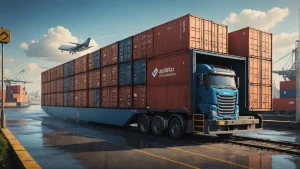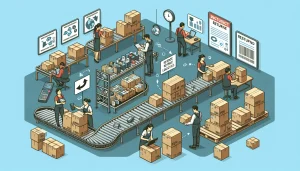Unraveling the DNA of efficient ecommerce logistics is not an option anymore. It’s a necessity.
Virtual aisles of bustling e-commerce landscapes are echoing one thing – the future of business lies in mastering efficient ecommerce logistics operations. Regarded as a game-changer, it is the knight in shining armor businesses are relying on.
This potent power player, ecommerce logistics, is the foundation that fortifies the backbone of modern businesses. Consider it like this: e-commerce logistics is something as bedrock as oxygen for human survival, for sustainable business growth. The sooner you decide on its importance, the faster you leap ahead in the crowded e-commerce cosmos.
The Global ECommerce Logistics Market
The global ecommerce logistics market size was valued at 341.02 billion in 2022 and is predicted to reach 2518.28 billion by the year 2031.

Lower your delivery costs by 23%
How we reduce costs:
- No delivery vehicle expenses
- Optimized local routes
- Pay-per-delivery model
- Average 23% delivery cost reduction
Unraveling Ecommerce Logistics: A Comprehensive Definition
E-commerce logistics: a potent tool that allows businesses to transcend physical and temporal bounds, delivering goods right to the consumer’s doorstep. It’s a vast playing field that requires a deep dive. So, what’s the clue? Below are the key points that will be addressed:
Understanding the Concept of Ecommerce Logistics
It is a facet of logistics that primarily targets the activities surrounding eCommerce business. It encompasses a plethora of functions such as warehousing, packaging, payment, goods delivery, and customer service. It is a free flow of data, goods, and cash.
Definition of ecommerce logistics
Despite the vibrant world of e-commerce logistics, its core revolves around a simple notion – moving products from the retailer to the customer as efficiently and effectively as possible. It specializes in managing, controlling, and executing the storage and transportation of goods sold through the online store platform. Learn how to establish a local e-commerce delivery service that enhances your online store’s logistics by effectively managing the transit of goods from storage to your customer’s doorstep.
How it differ from traditional logistics
Juxtaposed with traditional logistics, e-commerce logistics has a unique twist. Traditional logistics focused on bulk shipments sent to physical stores or distribution centers. There was no need for last-mile delivery or individual packaging. Conversely, e-commerce logistics are tailored to individual orders, requiring a highly efficient last-mile delivery system, personalized packaging, and return logistics.
The Integral Components of Ecommerce Logistics
Ecommerce logistics isn’t a single cogwheel. It’s an intricate machine where every component plays a critical role.
Warehouse Management System
Warehousing in ecommerce logistics isn’t merely a storage area. It’s a dynamic environment where products are tagged, tracked, and promptly dispatched upon order.
Inventory management
Inventory management is integral to ecommerce logistics. It involves tracking and reporting stock levels in real-time, preventing overstocking and stockouts, unfavorable conditions leading to order cancellations, and a tarnished brand image.
Order fulfillment
The meat and bones of eCommerce logistics process is order fulfillment – here, the order is processed, picked, packed, and made ready for shipping. All while maintaining speed and accuracy, to enhance customer satisfaction and loyalty.
Average Cost of Ecommerce Order Fulfillment
The average cost to fulfill an ecommerce order is 70% of the average order value.
Shipping and delivery
Shipping carrier and delivery – this is where the rubber hits the road. Ecommerce supply chain shines in its ability to deliver orders to customers’ doorsteps promptly and accurately – testing the entire supply chain network. Learn the nuances between delivery and shipping, and explore strategies to enhance your eCommerce supply chain’s efficiency and precision.
In the grand scheme of things, e-commerce logistics is versatile. It’s all about handling the online order fulfillment process with the utmost care – from receiving the order to the product landing at the customer’s doorstep. Every cog in this machine needs to work in perfect harmony to deliver a seamless shopping experience. With the essentials at your fingertips, you are well on the path to cracking the code of e-commerce logistics.
The Ecommerce Logistics Process: A Step-by-Step Guide
Step 1: Receiving and Storing Inventory
The function of an e-commerce system starts behind the scenes, with the receipt and storage of goods. Inventory arrives at warehouses from various suppliers and manufacturers. Upon arrival, it must be inspected for accuracy and potential damage, given barcodes, and stored appropriately to ensure easy accessibility for when orders arise. Discover how an essential dispatch note helps keep this inventory process organized and accurate, laying the foundation for efficient order fulfillment in e-commerce operations.
Physical space management is crucial to effective warehousing as inefficient storage can render inventory inaccessible, misplaced, or damaged. Advanced warehouse management systems (WMS) help by tracking and positioning items for optimal space usage and order-picking efficiency.
Step 2: Order Processing and Fulfillment
Once a customer places an order, it triggers a series of events to ensure the right product gets to the consumer. The order processing stage begins as soon as the customer makes a purchase. This involves pulling the product from inventory, inspecting it for quality, and then packing it securely for dispatch.
Order fulfillment can make or break the customer’s shopping experience, highlighting its significance. Speed, accuracy, and cost are three interdependent factors that businesses constantly try to balance in this stage. Technology, automation, and smart inventory management practices offer significant leverage in fulfillment center.
Step 3: Shipping and Delivery
Shipping is the transport of the ordered products from the warehouse to the customer’s door. It involves multiple considerations like service levels, costs, carriers, and geography. Businesses strive to deliver orders swiftly, safely, and economically while tracking the shipment status until customer receipt. Discover the price for your next shipment instantly—use our local delivery price estimator to obtain a tailored cost assessment effortlessly.
Handling the so-called “last mile delivery” significantly impacts customer satisfaction. Increasingly, companies leverage data analysis and technological solutions to ensure speedy, cost-effective delivery without compromising on the product’s condition upon arrival.
Step 4: Returns Management
Even with the most impeccable fulfillment process, returns are inevitable in e-commerce operations. Returns management is a critical, often neglected aspect of reverse logistics. Businesses must set up a streamlined process of receiving returned items, managing refunds or exchanges, and returning the inventory to shelves or discarding it.
A clear, hassle-free returns policy can enhance customer trust and loyalty. Digital tools can assist with returns authorization, tracking, and restocking, simplifying the processes and reducing errors—especially when paired with a virtual phone number for easy customer communication.
Why E-commerce Logistics is Crucial for Your Business
Now that we’ve walked through the e-commerce logistics process, let’s delve into why this aspect is so critical to any business.
Enhancing Customer Satisfaction
As customers, we crave instant gratification. In the context of e-commerce, this manifests as the delivery of orders as quickly, accurately, and smoothly as possible—a feat achievable through proficient logistics.
Logistics in e-commerce isn’t merely about moving products from point A to point B. It’s about the entire process: taking the right product, packing it properly, dispatching it quickly, and delivering it promptly to the right customer. Simply put, it’s about fulfilling the promise made to the customer when they click on ‘buy now’.
Every part of this promise hinges on effective logistics and precise execution. When businesses achieve this level of service consistently, the outcome is simple: happier customers. And happier customers equate to higher customer retention and loyalty, favorable reviews, and more referrals.
Streamlining Business Operations
Any e-commerce business involves a multitude of operations—all of which logistics plays an integral role.
A successful e-commerce business relies on a seamless flow between inventory management, order processing, delivery, and returns management, making logistics the heartbeat of your business. When companies recognize the significance of logistics and invest accordingly, they’re rewarded with smoother operations.
Think of it as a well-oiled machine. A business smoothly running, with fewer glitches and bottlenecks, makes for increased productivity and efficiency. This focus on efficiency can drastically reduce operational expenses in the long run.
Boosting Business Growth
The ladder to business growth in the e-commerce world is paved with logistics.
Better customer satisfaction, efficient operations, and cost savings, all these benefits of effective logistics culminate in one outcome: business growth. With stellar logistics performance, your business commands a reliable and reputable presence, enhancing your brand image.
But that’s not where the story ends. High-quality logistics can enable businesses to scale up and venture into newer markets with confidence. The key is laying a robust logistics foundation to support your ambitious business expansion plans.
E-commerce logistics can be a game-changer if correctly executed. The perks are substantial, from satisfied customers to business growth; facilitating business to thrive and stand out in today’s cutthroat e-commerce world.
Growth of eCommerce Logistics
The eCommerce logistics market is expected to grow at a CAGR of 17.8% from 2023 to 2033.
The Tangible Benefits of Ecommerce Logistics for Businesses
Reduced Operational Costs
Unlike traditional brick-and-mortar stores, e-commerce businesses don’t need to shell out huge capital for physical shops, warehouses, or inventory handling. Leveraging logistics can provide them with the resources needed to manage their operations without being buried in operational costs. They can utilize aid from professional logistic solutions to effectively transport, store, and deliver their products. This, in turn, results in reduced overall costs
Moreover, with a network of warehouses and transportation systems offered by logistic providers, e-commerce businesses can expand their reach significantly. This opportunity can further lower shipping costs and return freight expenses.
Improved Inventory Management
Inventory management is one of the most critical challenges in the e-commerce business. The right logistics management not only streamlines this process but also helps to avoid problems such as stockouts or overstocking.
Avoiding Stockouts
To preclude the chance of stockouts, logistics provides a real-time inventory tracking system. This ensures that necessary stock is readily available to meet the customer demand promptly.
Preventing Overstocking
Overstocking is an unnecessary expense that can be mitigated by logistics. Accurate forecasting methods in logistics can predict consumer demand accurately, eliminating wastage due to excessive stock.
Enhanced Customer Experience
Quality of service is vital in e-commerce operations. It isn’t enough to offer a wide range of products if they are not delivered on time and in perfect condition. This is where logistics plays a vital role.
Faster Delivery
An efficient logistics system ensures faster delivery by eliminating unnecessary bottlenecks. This leads to less wait time for customers, enhancing their buying experience.
Quality Assurance
Besides, a robust logistics system implements stringent quality checks to ensure the product is delivered damage-free. This results in improved customer satisfaction and loyalty towards the business.
Logistics in e-commerce isn’t just an operational need; it’s a game-changer. It leverages businesses to compete, grow, and satisfy their customer base, making it an indispensable asset in today’s digital world.
Navigating the Challenges in E-commerce Logistics
Managing High Shipping Costs
The realm of e-commerce logistics is fraught with the predicament of high shipping costs. Some national postal services may exhibit inflated prices, while other private courier services may be cost-prohibitive for small businesses. Managing these shipping costs is crucial for maintaining profitability and customer satisfaction. Implement strategies to lower your online store’s shipping and handling expenses, ensuring your business remains competitive and keeps customers coming back.
Traditional brick-and-mortar stores generally have the luxury of a one-time freight cost from the warehouse to the retail outlet. In stark contrast, e-commerce businesses encounter shipping costs each time a product gets delivered to a customer’s door. Balancing affordability with reliability and speed can be a tricky equation to solve. Hence, identifying the top ecommerce shipping companies that can fuse affordability with expediency is crucial for the success of any online shopping platform.
There are certainly ways to navigate these, including choosing the right shipping partner, efficient packaging, and negotiation for bulk shipping rates. Adopting strategies like free shipping thresholds and considering delivery location-based pricing can also contribute to cost-effective e-commerce logistics.
Transportation Segment
The Transportation Segment is a major contributor in the E-Commerce Logistics Market based on service type, with a market share of 67.3% in 2022.
Handling Returns and Refunds
Returns and refunds inevitably pose a complex challenge within the e-commerce logistics landscape. On one hand, they are often a nuisance from the logistical viewpoint, requiring extra man-hours, reversal of processes and often resulting in a financial hit. On the other hand, a generous return policy is almost mandatory to foster customer trust and loyalty in today’s competitive business environment. Discover how to streamline your returns management by implementing effective logistics for reverse operations.
The key is to offer a compelling returns policy without letting it erode your profit margins – easier said than done but not impossible. Streamlining your returns process reduces the time and effort put into refund-related operations and ensures your customer enjoys a seamless experience. Including detailed product information and descriptions, implementing a standardized returns management system, and offering instant refund options can showcase your business in a positive light while alleviating some logistical burdens.
Automating your returns and refund process using advanced software can also contribute to reducing return rates and improving customer satisfaction.
Dealing with Inventory Management Issues
Inventory management is another mountainous challenge faced by businesses venturing into e-commerce logistics. Balancing your inventory levels, avoiding stockouts or overstocks, and maintaining accurate sales forecasts can often prove to be a tough act.
While traditional businesses can operate with some degree of leniency, e-commerce businesses don’t have such luxury. Due to the online nature of transactions, inventory management needs to be near perfect as customers expect immediate gratification with constantly updated stock levels and immediate availability of goods highlighted on your website.
One effective solution lies in adopting robust inventory management software that tracks your stock levels in real time, provides sales forecasts, and triggers restocking alerts. Additionally, strategies like dropshipping or third-party fulfillment can be viable options to alleviate inventory issues, particularly for startups.
The Global B2C eCommerce Sales
The global B2C ecommerce sales reached $4 trillion in 2020 and are expected to grow to $5 trillion by 2022 and up to $6 trillion by 2024.
The Future of Ecommerce Logistics
The Role of Technology in Ecommerce Logistics
Technology is no longer a luxury; it’s become a necessity for e-commerce logistics. It’s gradually shaping the landscape, providing businesses with a competitive edge with efficient operations, reduced costs, and better customer service.
Revolutionary tech advancements like artificial intelligence (AI), machine learning, and blockchain are reshaping the procurement, storage, and delivery processes. AI’s predictive capabilities, for example, can help forecast trends ensuring optimal inventory management. The implementation of AI in logistics enhances these capabilities further, enabling smarter route planning and automation of warehouse operations, which significantly boosts efficiency and accuracy across the supply chain.
Additionally, the Internet of Things (IoT) contributes significantly to enhancing tracking capabilities and ensuring product integrity during transit. Drones and autonomous vehicles are also making strides in this space, potentially revolutionizing last-mile logistics soon.
The Impact of Ecommerce Logistics on Sustainability
Sustainability has become a significant point of interest in the e-commerce logistics field. It’s no longer just about economic growth, but also about making environmentally conscious decisions.
Packaging forms a crucial part of e-commerce, and businesses are moving to eco-friendly alternatives. Product packaging can significantly influence customer’s perceptions and purchase decisions, so investing in sustainable packaging can be a game-changer.
Moreover, carbon-neutral shipping methods and efficient route planning help in reducing greenhouse gas emissions. Several businesses now provide carbon offset shipping options, making sustainability a defining factor in their logistics strategy.
Preparing for the Future: Key Takeaways for Businesses
Key takeaways for businesses to prepare for the future of e-commerce logistics.
With the rapid evolution of e-commerce logistics, businesses must remain agile and adapt to the changing landscape. Investing in technology for seamless integration of supply chain activities, focusing on customer-centric approaches, taking sustainability into account, and staying relevant with robust strategies are fundamental.
Incorporating technology can significantly improve the business’s agility, and ability to predict trends, and synthesize large amounts of data into actionable insights. Eager to enhance efficiency by delegating your local ecommerce delivery? Learn how this approach can refine your process and slash expenses.
Lastly, sustainability should be a significant strategic pillar. Implementing green initiatives not only lessens a business’s ecological impact but also contributes to its branding and customer relations.
Harnessing Ecommerce Logistics: Because Your Business Deserves More
Streamlined ecommerce logistics promise enhanced customer satisfaction, lower operational costs, and a stronger edge in a fiercely competitive market. Leveraging advances in technology, you can manage inventory better, ensure faster delivery, and drive up your bottom line.
This isn’t just theory; it’s your potential reality. Ecommerce logistics are revolutionizing how businesses operate, offering a robust mechanism for growth and sustainability. If you’ve been grappling with low conversion rates, dwindling profits, or unsatisfied customers, improving your logistics ecosystem might just be the turnkey solution you need.
Now is the perfect time to review and optimize your current logistics strategy. If your competitors haven’t already done so, it’s only a matter of time before they do. Evaluate your systems; consider investing in advanced software. Consult logistics specialists to understand what improvements can be made specifically tailored to your business needs.
Have you considered the extent to which a robust logistics strategy can propel your business’s growth yet?
Remember, your logistics is not a static entity, but a dynamic, adaptable force that can truly redefine your business framework. So go ahead, and embrace the change. Because the world of e-commerce waits for no one.
Worldwide eCommerce Sales
Worldwide ecommerce sales were expected to grow at a rate of 14.5% in 2021, representing an estimated additional $600 billion in sales shifting from brick-and-mortar to online.






























